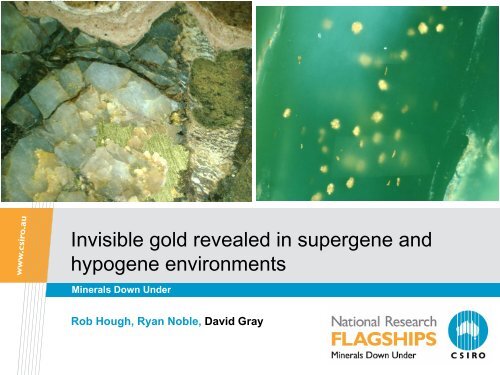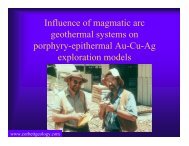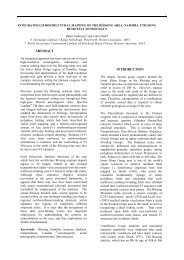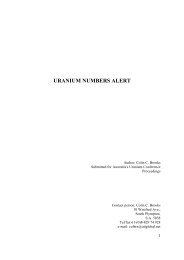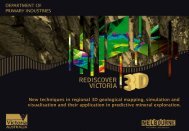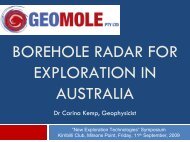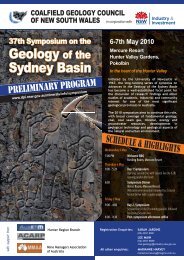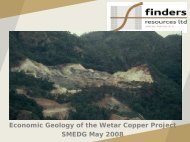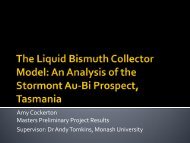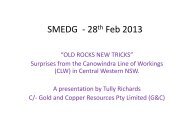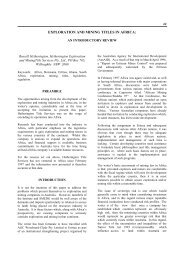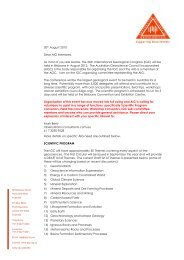Invisible gold revealed in supergene and hypogene environments
Invisible gold revealed in supergene and hypogene environments
Invisible gold revealed in supergene and hypogene environments
Create successful ePaper yourself
Turn your PDF publications into a flip-book with our unique Google optimized e-Paper software.
<strong>Invisible</strong> <strong>gold</strong> <strong>revealed</strong> <strong>in</strong> <strong>supergene</strong> <strong>and</strong><strong>hypogene</strong> <strong>environments</strong>M<strong>in</strong>erals Down UnderRob Hough, Ryan Noble, David Gray
Hidden depositsInsert presentation title
Yilgarn Craton – Sal<strong>in</strong>ityModelledgroundwatersal<strong>in</strong>ities <strong>in</strong> theYilgarn Craton(Comm<strong>and</strong>er, 1989)KilometresInsert presentation title
Dissolved Au Concentration – Yilgarn Craton706050Frequency(%) 40NorthernCentralKalgoorlie3020100.005 - 0.010.01 - 0.020.02 - 0.040.04 - 0.10 - 0.00500.1 - 0.20.2 - 0.40.4 - 1> 1Insert presentation titleDissolved Au range (ppb)
Supergene depletion of Au <strong>in</strong> the Yilgarn CratonKilometresInsert presentation title
Complex regolith materialsInsert presentation title
Laser ablation transect of Au distributionInsert presentation title
Alunite rich ve<strong>in</strong>s with<strong>in</strong> slabby ferricrete (transported) Mount GibsonBulk analyses of: Au 0.1 ppm, As 36 ppm, Cu 85 ppm.Au: 2.9 ppmCu: 320 ppmAs: 430 ppmPb: 420 ppmAu: 1.5 ppmCu: 280 ppmAs: 340 ppmPb: 560 ppmF<strong>in</strong>e-gra<strong>in</strong>ed, Fe-sta<strong>in</strong>edkaol<strong>in</strong>ite/aluniteAu: 1.6 ppm, As: 360 ppm, Cu:290 ppm. Pb: 700 ppm(EMPA/LA-ICPMS)300 μmHough et al., 2005; 2007Insert presentation title
4Dissolved Au vs. Fe (pH < 5.4)AuCl 2- + Fe 2+ + 2H 2 O ⇒ Au (S) + FeOOH + 2Cl - + 3H +Dissolved Au (ppb)321pH 3.4,Eh 600 mVNorthernCentralKalgoorlieEastern215 ppmFe00 10 20 30 40 50 60Insert presentation titleDissolved Fe (ppm)
Golden Virg<strong>in</strong> Pit, Parker Range (WA)Insert presentation title
Primary <strong>gold</strong> <strong>in</strong> quartz, iron oxide (after sulphide).13-15 % Ag <strong>in</strong> the Au-Ag gra<strong>in</strong>s4 mmsulphidef<strong>in</strong>e Au <strong>in</strong> qz1 mmInsert presentation title
Quartz ve<strong>in</strong> block from 30 m depthIron oxide rich fracture surface100 μm1cmInsert presentation title
SEM: Back-scattered electron imagesInsert presentation title
Th<strong>in</strong> films – overlap illustrates thickness effectson atomic number contrastInsert presentation title
Electron transparent <strong>gold</strong>Insert presentation title
Insert presentation title
Insert presentation title
Insert presentation title
Octahedra precipitated later (dry<strong>in</strong>g phenomenon)Insert presentation title
Insert presentation title
Faraday 1850 – changed <strong>gold</strong> sols blue from red‘known phenomena seemed to <strong>in</strong>dicate that a mere variation <strong>in</strong> thesize of [<strong>gold</strong>] particles gave rise to a variety of resultant colours’Insert presentation title
Nanoparticulate <strong>gold</strong>• Colloidal suspension• Affects UV-Vis <strong>and</strong> colour ofsuspensions• Controlled growth of size <strong>and</strong>shape of particleTsuji et al., 2005• Stable form of transport: colloidcan rema<strong>in</strong> stable up to 400°C(relevant to hydrothermaltransport)Insert presentation title
Insert presentation title
Insert presentation title
Insert presentation title
Gold nanoparticles <strong>in</strong> refractory oresPalenik et al., 2004Insert presentation title
Gold chloride evaporation: Extractable <strong>gold</strong>Insert presentation title
Hough et al. 2008 GeologyAfter An<strong>and</strong>. 2007Insert presentation title
arytes – evaporite ‘rose’Insert presentation title
Us<strong>in</strong>g LA ICP MS to study nature of <strong>gold</strong> <strong>in</strong> calcreteL<strong>in</strong>tern, 2008LA ICPMS traverse across polishedsection of Au-rich calcrete (arrowed)• 20 samples studied to date• Au is “nuggetty”• Au-rich zones not related to other geochemistrye.g. Ca• Au peaks appear not related to micro fabricfeatures• Results consistent with evapotranspiration modelfor Au accumulation <strong>in</strong> calcrete120000counts 197 Au80000400000Insert presentation title0 2000 4000 6000 8000 10000 12000 14000 16000 18000 20000 22000 24000 26000 28000distance (μm)
Maia-96 at the Australian Synchrotron – XFM l<strong>in</strong>eRecent data from XFM beaml<strong>in</strong>e, AS December 2008 trialsRun (#304): Bounty deposit, WARegolith, calcreteMel L<strong>in</strong>tern, CSIRO 2009Au correlated with BrAuBrAPS: 117 x 203 pixels(0.7 x 1.1 mm 2 )1 s dwell, 6 x 6 µm 2 pixelsTranslucent to high-energyX-rays: Rb K, Sr K, beamDr Mel L<strong>in</strong>ternCSIRO Exploration <strong>and</strong> M<strong>in</strong><strong>in</strong>gBr-Au-Fe RGB compositeXANES: Au+ ionicXFM beaml<strong>in</strong>e, 20.1 keVBeam size φ ~ 1 µm 210 x 10 mm 2 , 8000 x 8000 pixels (1.25 µm, 0.6 ms “dwell” per pixel)Sr-Fe-Rb RGB compositeGeoPIXE 4.6 Dynamic AnalysisInsert presentation title
Colloidal nanoparticulate <strong>gold</strong> <strong>and</strong> sulphates:Evaporation• Stable colloidal transport of <strong>gold</strong>, some differences <strong>in</strong>precipitate from different lig<strong>and</strong>s but still {111}crystals.• See<strong>in</strong>g ‘<strong>Invisible</strong>’ <strong>gold</strong>.• Gold transport <strong>in</strong> areas where sal<strong>in</strong>e groundwaters<strong>in</strong>teract with <strong>gold</strong> deposits worldwide.• Sulphates an important m<strong>in</strong>eral host for <strong>gold</strong> <strong>in</strong> theregolith <strong>in</strong>clud<strong>in</strong>g <strong>in</strong> weathered sedimentsInsert presentation title
Insert presentation title
Insert presentation title


